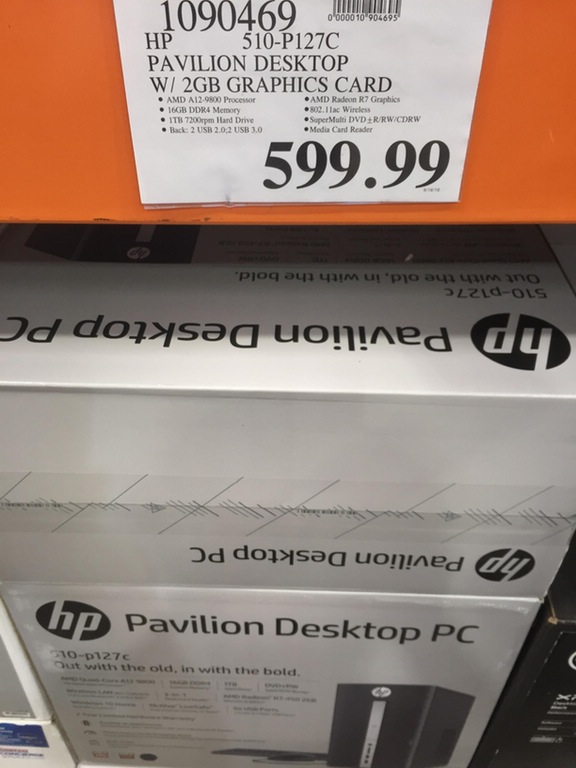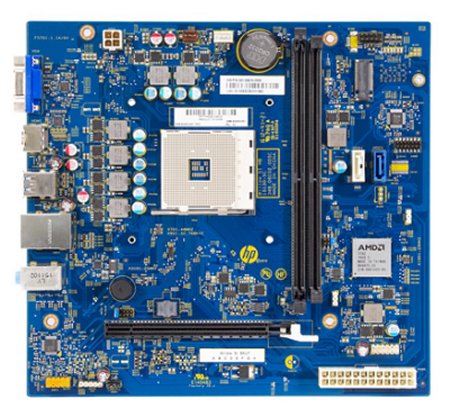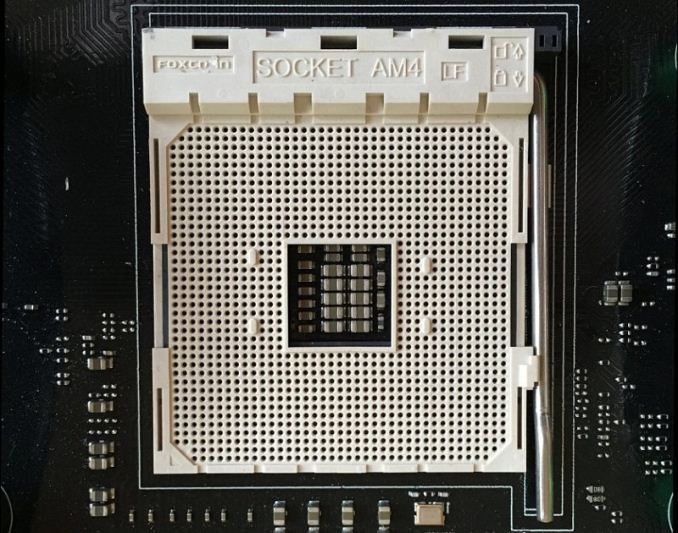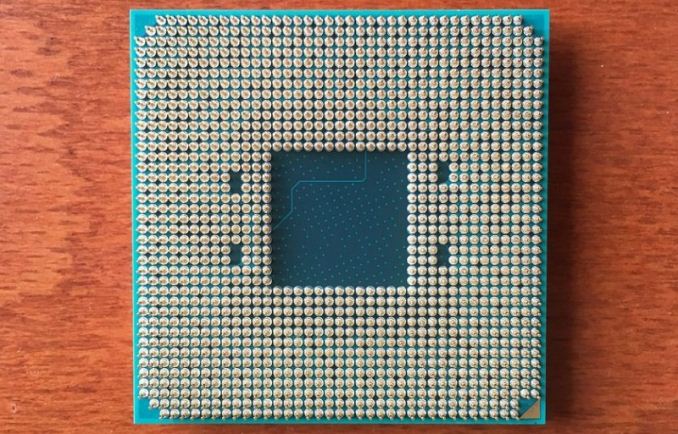AMD 7th Gen Bristol Ridge and AM4 Analysis: Up to A12-9800, B350/A320 Chipset, OEMs first, PIBs Later
by Ian Cutress on September 23, 2016 9:00 AM ESTMotherboards, Sockets, Pins and Things
As an OEM only launch, details about exact systems coming to market (and how they are designed) is providing slim pickings. With a normal retail launch, we have several motherboard manufacturers to dig our teeth into when asking questions, however our relationships with the major OEMs such as HP, Dell or Lenovo are quite different and typically more product focused and less engineering. We’ve not seen any real Bristol Ridge related announcements on OEM systems coming into the market, but some do exist. Reddit user starlightmica saw this HP Pavilion 510-p127c in Costco this week:
$600 gets an A12-9800, 16GB of DDR4, a 1TB mechanical drive, an additional R7 2GB graphics card, 802.11ac WiFi, a DVDRW drive, and a smattering of USB ports (but no USB 3.1, which is interesting).
We reached out to HP, as this system was listed online with the blurriest of motherboard images.
This is a ‘Willow’ motherboard, and we can see the AM4 socket in the middle. Contrary to previous platforms, it is worth noting that the socket mounting holes are significantly more ‘square’ than previous motherboard designs. However, when we discussed the images of the South Korean overclocker near the beginning of this article, it looked like he was using a standard AMD Wraith cooler, which might suggest that this square mounting hole situation might just be HP designing the motherboard.
The board clearly has six phases as part of the power delivery, plus an additional phase for the memory. I would assume that since the system has dual channel support, HP has developed the two memory slots as having dual channel capability, and the abundance of traces from the APU seems to suggest that as well.
To the right of the DRAM slots seems to be a PCIe x1 slot, which is where I assume the WiFi module is held. Below this slot are two of the system SATA ports, followed by what looks like a chipset with a big AMD logo on it and then the 24-pin power connector.
The motherboard has a full PCIe 3.0 x16 sized slot, although as we discussed before, this will be limited to PCIe 3.0 x8 due to the design of the processor. To the left of this is clearly a Realtek audio codec, and judging by the 2.1 support on the rear panel, this is most likely an ALC269 or some other low-end codec. It is hard to tell where the network controller is here without the high-resolution image, but just above and to the left of the speaker looks like a small IC which looks similar to Realtek’s low-end solutions. Typically Realtek offers a deal when audio+networking chips are used in the same system, so I suspect that is what is happening here. Above this are our USB ports, an HDMI output, and a VGA port which must be using a DP-to-VGA IC onboard.
We have closer up images of the socket, thanks to the Hungarian website hwsw:
This looks like the standard ZIF socket we’ve come to love/loathe from AMD (I doubt there’s a way that keeps everyone happy anyway), and others have counted 1331 holes which may/may not do things.
The rear of the CPU, also from hwsw, is what we would expect given the socket layout. It does mean that AMD is stuck at this level of connectivity, to anyone wishing for a quad-channel AMD platform suitable for consumers will have to wait until a future platform. It’s also worth noting that this looks like a similar size to when AMD CEO Lisa Su held up a Zen chip for the press back at the Zen announcements in August.
What Happens Now
Aside from spotting systems like the HP in Costco, no doubt a number of media outlets (us included) are trying to get hold of a number of the APUs for official reviews. As mentioned previously, that A12-9800 looks like an exciting all round part. We are working with AMD to secure the platform and the APUs for testing.
AMD has told us that Bristol Ridge APUs are designed to have price parity with the current Kaveri Refresh/Godavari models, however exact configurations of APUs and coolers, as well as a timeframe for the motherboard manufacturers to come out with their designs, is still to be decided.
I suspect that AMD will wait until closer to the Zen launch window to put Bristol Ridge on the shelves. Attacking the market with a new platform that goes from the high-end desktop through to all but the cheapest systems would mean a concerted effort to gain market share and recognition for catering to the performance needs of as many users as possible all at once. AMD has promised that Zen will trickle down the stack, however as we were told regarding their server and laptop plans later in 2017, that will mostly likely occur later in the year also.
If you’ve read through this piece, or merely skipped to the last page for the conclusions, here’s the take away from the Bristol Ridge for desktop launch:
- OEMs first, DIY builds later
- The A12 at 65W has better specifications than the best previous generation A10 at 95W
- Even at 65W, there is +30% frequency on the integrated graphics for the A12-9800
- The chipsets support USB 3.1 (10 Gbps) natively, but Type-C requires a small additional chip
- Bristol Ridge is more like an SoC, the chipset is entirely optional
- There are so many fun things you can do with PCIe and switches
- We expect the retail APUs to be price drop-ins for current APUs
- We’re trying to get these APUs for review. Stay tuned.





















122 Comments
View All Comments
Danvelopment - Tuesday, September 27, 2016 - link
Your processor alone is almost $200. You can buy a motherboard, chassis, 80+ psu (what Dell uses in their optiplex's), (well exclude the aftermarket cooler, extra fans and optical for fun sake), and 4gb ram for $83 including ship(200-157+40)? I'm impressed. Care to spec that up?Plus the price of the parts you were going to add to the $200 machine.
And your choice in bench appears to be severely lacking in benchmarks but I see there aren't many ivy i5s, can get ex lease ivy i7s for about $30 more.
jardows2 - Tuesday, September 27, 2016 - link
I had hoped for more numbers in Bench, but I guess the i3's don't get the same attention here. I didn't really want to link to "rival" review sites here in the comments. Main point was that the Skylake i3's are not that dramatically slower than Ivy i5's.i3-6100 is pricing around $120 USD, $110 on sale. Asus B150M-A/M.2 is about $80, but I live close to a MicroCenter, so their combo deal knocks $30 off that price. Crucial MX300 M.2 for $70, 8GB of DDR4 for $35, 1TB hard drive for raw storage at $45, Case/PS for $65. Use my own license for OS. That comes up to ~$415-$445 for a brand new computer.
Main point, I can get a new computer for not much more than a used computer, once I bring the used computer up to my specification. Having a new computer over a used computer for me is more important than the performance difference of the i5.
Danvelopment - Tuesday, September 27, 2016 - link
It's not really building a new machine if you're reusing old parts, if you're talking the general populace rather than you personally (my target) they won't have the option of moving their Windows license, and there's a clock drop on the i3-6100 relative to the benchmarks earlier.Also a chassis/PSU for $65 doesn't sound like a very good option. Going back to Dell (my old company was Dell heavy so I have a lot of experience with their enterprise lines, HP, Lenovo etc will probably be the same). The Optiplex chassis' were almost entirely toolless, well cooled and the 790 onwards looked decent, albeit not incredible (but a $65 chassis/PSU wouldn't). On top of that they used 80+ PSUs (the 3000/7000/9000 series used Gold, I can't remember if the older ones were the same), proven, quality units. i5/i7 builds also used Q series motherboards with Intel components (such as the NIC).
If you're matching quality like for like then you'd be looking to spend more on the new machine. I'd much rather personally run a secondhand Ivy i5/i7 using quality components. Their consumer lines are garbage from my experience but ex-lease machines are all enterprise devices.
Being able to do something doesn't make it a better option, especially if you drop the quality to do so. Ivy i5, even to the benchmarks above is more powerful, ex-lease component machines are higher quality and even with the above it's still cheaper. It just makes sense.
Danvelopment - Tuesday, September 27, 2016 - link
I don't work there anymore but I liked the Dell enterprise machines so much that I actually bought an (ex-lease) E7240 after I left. i5-4200U, 4GB RAM (I added another 8 that I had lying around), 256GB OEM SSD for $200. I can flip the back off with two screws and access almost everything. And the screen front bezel just pulls off with fingernails, although you wouldn't know it til you tried. You don't have to unbolt the hinges like most laptops.Before I started there they bought Vostros (laptop and desktop) for some reason, rather than the enterprise machines and fark those things. They were the hardest farking things to work on, they literally went out of their way to make it hard. I phased the final ones out just before I left. It was the Vostro 3450 that was my most reviled computer ever. The hard drive was screwed onto the motherboard and you literally had to pull the whole thing apart, lift the motherboard then unscrew the HDD from it. If you took the back panel off, you could have done it from there but they put a small band of plastic on the bottom chassis to prevent it. It literally had no other purpose. If there was no warranty you could take a knife, cut that plastic off and do it directly.
Look at this joke of a thing:
http://www.laptopultra.com/guide/wp-content/upload...
https://i.ytimg.com/vi/6QwZ71iAdLA/maxresdefault.j...
4fifties - Friday, September 23, 2016 - link
If DIY motherboards, which presumably would allow either Bristol Ridge or Summit Ridge, follow the pattern of this OEM board, aren't we consigning Zen to just eight lanes of PCIe 3.0 for discrete graphics? Not necessarily an extinction-level event, but neither is it something gaming enthusiasts will be happy with. Hopefully, motherboard manufacturers won't drop the ball with this.prtskg - Friday, September 23, 2016 - link
I think both Summit ridge and Raven ridge will have better chipset(enthusiast level).KAlmquist - Saturday, September 24, 2016 - link
I take it you are thinking that the AM4 socket has more than 12 PCIe lanes, but that Bristol Ridge doesn't connect them all (sort of like the Intel i7-6800K has 28 PCIe lanes even though it uses a socket that has 40 lanes). That makes sense.My guess is that motherboard manufacturers expect AM4 motherboard sales to be driven primarily by Zen. In the DIY market, even the people who do buy a Bristol Ridge processor may be doing it with the intention of upgrading to a more powerful processor later. So I would expect most motherboard manufacturers would try to do a good job of supporting the Zen-based processors.
MrCommunistGen - Friday, September 23, 2016 - link
It really looks like the connectivity onboard the APU is targeted at what a normal laptop would need. This should be a major design advantage for AMD compared to their previous mobile platforms in terms of power, design & material cost, and platform footprint.- This class of CPU doesn't warrant a x16 PEG Link
- Due to space constraints most non-DTR laptops will have fewer than 4x USB ports - maybe 3+1 USB-based card reader. They can probably use an onboard hub for more if they really need them.
- x4 PCI-E 3.0 M.2 is an option
In fact, other than USB ports, this is probably enough connectivity for most non-enthusiast desktop users as well. This could help BOM and board design costs here as well. The optimistic part of me would love to see that reinvested elsewhere in the system. Realistically I see that split between a lower sticker price and an increase in margins for the system builder.
stardude82 - Friday, September 23, 2016 - link
Almost certainly AMD is just reusing the Carrizo design as a cost cutting measure. There isn't a AMD CPU on the market which a x8 link would bottleneck first.Samus - Friday, September 23, 2016 - link
Nice to see AMD trumping Intel's Crystalwell GPU for half the cost...